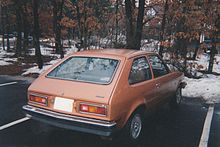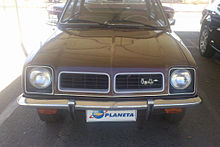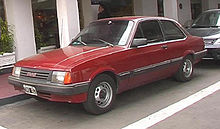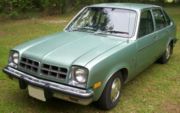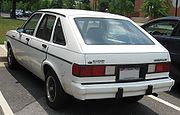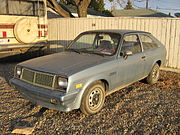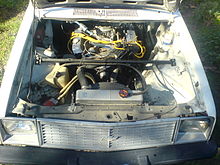- Chevrolet Chevette
-
Chevrolet Chevette 
1977 Chevrolet Chevette Rally 2dr HatchbackManufacturer General Motors Also called Pontiac Acadian Production 1975–1987 (1992 in Brazil/1996 in Ecuador/1998 in Colombia) Model years 1976–1987 (1992 in Brazil/1996 in Ecuador/1998 in Colombia) Assembly Wilmington Assembly, Wilmington, Delaware, United States
Lakewood Assembly, Atlanta, Georgia, United States
Alvear, Santa Fe, Argentina (as the GMC Chevette),
Sao Caetano do Sul, Brazil[1]
Bogotá, Colombia [2]
Aymesa, Ecuador
Valencia, Venezuela.Successor Chevrolet Sprint (Canada)
Geo Metro/Chevrolet Metro (United States)
Chevrolet Corsa (in Argentina, Brazil, Colombia, Ecuador and Venezuela).Class Subcompact Body style 3-door hatchback
5-door hatchbackLayout FR layout Platform T-body Engine 1.4 L I4
1.6 L I4
1.8 L Isuzu diesel I4Transmission 4-speed Saginaw manual
5-speed Borg-Warner T-5 manual
3-speed GM HydramaticWheelbase 97.3 inches (1978 4 door), 95.3 inches (1978 2 door) Related Pontiac T1000
Opel Kadett, Vauxhall Chevette
Isuzu GeminiThe Chevrolet Chevette was introduced in September, 1975 and manufactured for model years 1976-1987 based on GM's worldwide T platform and superseding the Vega as Chevrolet's entry-level subcompact. The Chevette was the best-selling small car in America for 1979 and 1980, and was popular in South America as well.
Contents
History
Overview
The T-car was first launched in Brazil under the Chevette name in 1973, as a two-door sedan; the Brazilian Chevette line eventually included a four-door sedan, a two-door hatchback, and a two-door station wagon (named Marajó), as well as a pickup (named the Chevy 500), and was produced until 1994. Chevettes are also a car used in racing in Dirt Track Racing. It has its own series. The Chevette was probably the last rear-wheel drive FR subcompact built in the world (produced until 1998 in Colombia; the VW Beetle was built in Mexico until 2003 but it had a different layout, namely rear-wheel drive, rear engine) until BMW launched its 1 Series in 2004.
Initially available only as a two-door hatchback with 1.4 or 1.6 L OHC gasoline inline-four engines, the Chevette engines produced from 53 to 70 horsepower (40 to 52 kW) at the rear wheel. A four-speed manual transmission was standard; a three-speed automatic transmission was optional. Rally and Woody packages were optional, as well as a loss-leader Scooter, a two-seater (rear seat optional) with painted rather than chromed bumpers, an open glove box, black carpeting, and door pull straps in lieu of arm rests. The Canadian market also had a Pontiac version of Chevette named Acadian. As the smallest, most fuel-efficient car marketed by Chevrolet, it was the lightest American car at the time being offered, weighing in at under a ton. The EPA rated the base 1.4-liter engine at 28 miles per US gallon (8.4 L/100 km; 34 mpg-imp) city and 40 miles per US gallon (5.9 L/100 km; 48 mpg-imp) highway—figures unheard of in past domestic models. Chevrolet claimed that a Chevette's turning circle (30.2 feet) was one of the smallest in the world and that it was essentially a "metric" car, "international in design and heritage."[3] 1976-1978 Chevettes can be identified by round headlights and a chrome-rimmed, tri-color taillights.
Models and changes (1976–1987)
The Chevette Rally 1.6, included a 1.6-liter (98 cu in) engine in lieu of the 1.4-liter (85 cu in) overhead-cam four-cylinder, rated at 60 hp (45 kW) instead of 52 hp (39 kW). The Rally also featured a suspension with rear stabilizer, along with special body graphics. Through model year 1976, the Chevette Woodie carried wood simulating sheet-vinyl trim and upgraded interior/exterior trim. The Woody model has become quite scarce, especially in higher condition grades. Chevrolet marketed the Chevette Scooter model with a MSRP of $2,899, without a rear seat or glovebox door. 9,810 Scooters were built, versus 178,007 regular hatchbacks. Buyers could choose either a fully synchronized floor-shifted four-speed manual transmission or optional Turbo-Hydramatic. Chevettes had rack-and-pinion steering, front disc brakes, a front stabilizer bar, 13-inch tires, tri-color taillights, front bucket seats, and an onboard diagnostic system. Swing-out rear quarter windows were optional.
The 1977 Chevrolet Chevette's engines offered 57 hp (43 kW) or 63 hp (47 kW). The Scooter hatchback included a rear seat. The Sandpiper trim package included “reef” patterned interior, deluxe door trim, cream gold or antique white exterior colors and an exterior Sandpiper logo just behind each door.
1978 models had a revised grille with a grid design, grille and headlight frames chromed for standard models, a four-door hatchback riding a 97.3 inches (2,470 mm) wheelbase was added — two inches longer than the two-door — and this version accounted for more than half of Chevette's nearly 300,000 sales. The 1.4 L engine and Woody were dropped. Fuel door added. TH-180 Automatic Transmission added to replace THM-200 series automatic. "HO" High Output version available in addition to the standard 1.6 L featuring a modified head and larger valves/cam profile. "HO" package also includes dual outlet exhaust manifold. Prices dropped and more standard equipment was added for 1978.
In 1979, the Holley two-barrel carburetor was now standard on all models. The front fascia was face-lifted with a flat hood, no longer wrapping down to bumper. New for 1979 was a large chrome grille with Chevrolet "Bow-Tie" emblem and square headlights. P.A.I.R. air injection system was introduced to improve catalytic converter function at idle. Active Passenger Restraint system was introduced in small numbers as an option which featured lower hanging dashboard, automatic seatbelts and a center dash console. Chevette sales totaled more than 451,000 units — a figure that would rank it second only to Chevy's new Citation, which had a much longer model run (sales had started in April 1979). Consumer Guide testers managed "an honest 29 mpg in the city and 39 mpg on the highway." The 1980 rear fascia was revised with a squared-off hatch, wraparound taillights with combined, single colored turn signals and a round gas filler door.
In 1981, a Diesel engine option was new with a late 1981 availability — (1.8 L Isuzu unit). New styled steel wheels with center caps were offered and the previous wheel/hubcap design was discontinued. U.S. models received a new Computer Command Control feedback system on gasoline engines. The H.O. option was discontinued. EST (Electronic Spark Timing) was used on 1981 models only in place of manual timing advance. A new engine cylinder head design (swirl-port) is introduced to improve low-end torque and fuel economy. The Pontiac T1000 was introduced which shared all body stampings with Chevette, featuring a chrome center w/black trimmed grille & headlight buckets as well as standard chrome window trim with black area fill. Power steering was a new option (automatic trans. & A/C only) as well as a 3.36 axle ratio (standard on T-1000 models). The Active Passive Restraint system was discontinued. New lighter weight bucket seats were introduced that lacked much of the lower support of the heavier "panned" seats. A new adhesive-based, thinner windshield seal replaced the lock-ring type.
Chevrolet sold 433,000 Chevettes in 1981 and 233,000 in 1982. 1982 models featured a five-speed manual transmission option on gasoline-powered two-door cars (standard with diesel). The Scooter was newly available in four-door hatchback. New GM THM-180C (THM200C for diesel model) automatic transmissions, which include a locking torque converter for greater fuel mileage. Introduction of pump driven A.I.R. system in late model year replaced P.A.I.R. to help efficiency of the catalytic converter. A new catalytic converter introduced with an air inlet for forced air injection from the air pump. A new one-piece cardboard based headliner, with updated over-head dome light, replaced the vinyl liner. Pontiac T-1000 received unique grille, body molding and vertical lined taillights as well as an alloy sport wheel option. GM of Canada's Pontiac Acadian, a rebadged Chevette, received all the T-1000's Pontiac-exclusive features from this point on.
1983 Chevettes had a makeover for the front and rear fascias, Chevette CS introduced. Black finished grill and trim moldings replaces most chrome pieces. Scooter and base Chevettes featured black bumpers and end-caps while the higher-end Chevette CS models included color-keyed bumpers and caps with chrome bumper inserts as an option. Scooter and base models featured black-only grill and headlight buckets while CS models feature argent colored trim. Chevette S model introduced as a cosmetic package that includes black painted styled-steel wheels and red-accented grill and moldings as well as over-sized decal emblems in red. Front bucket seats featured new adjustable knobs on the sides, but lost the reclining levers of previous years. Interior trim was also blacked out with new black door handles and black plastic window regulators. Integrated cassette deck optional with stereo package. Chrome strip on dashboard available only on CS & S models until end of production. Deluxe door panels were discontinued, all models featured plastic door panels, however base and Scooter models still featured laminated cardboard cargo area panels. The "Diagnostic Connector" was removed from wiring harness.
For 1984, the Scooter was discontinued. The T1000 was renamed "1000". 1985 carried few updates from the 1984 models. In 1986, the Chevette base model was discontinued leaving only the CS and the S, which featured a third brake light and an instrument cluster "Service Engine Soon" light, replacing the previous "Check Engine" light.
In 1987, Chevrolet dropped the Chevette S model and the diesel engine option (324 sold in 1986) and dropped the Chevette price to $4,995. Sales fell to just over 46,000 units, and production ended on December 23, 1986.[citation needed]
Successors
The Chevette effectively became the last domestic made subcompact from GM until 2011, when GM will introduce the Sonic to the United States and Canada. GM would not manufacture a Chevrolet subcompact in North America until 1994, when GM began building Chevrolet subcompacts in Mexico, although they are not sold in the United States and Canada. CAMI Automotive (by that time a joint venture between General Motors & Suzuki) began building the Canada-exclusive Chevrolet Sprint in 1989. In 1984, GM began marketing captive imports — rebadging cars from Toyota, Suzuki and Isuzu under the Chevrolet nameplate — introducing the Spectrum in 1984 (a rebadged Isuzu I-Mark), resurrecting the Nova nameplate for a rebadged Toyota Corolla hatchback) (1984), and marketing the Sprint (1985), itself a rebadged Suzuki Cultus. In 1989, GM reorganized its captive import and rebadged offerings under the now defunct Geo brand. The Nova became the Geo Prizm, the Sprint became the Geo Metro, the Chevrolet Spectrum became the Geo Spectrum and the brand began offering Isuzu Impulse-based Geo Storm as well as the Geo Tracker, also manufactured by Suzuki. GM Canada continued to sell the Chevrolet Sprint until 1991, when GM Canada announced it would introduce Geo to Canada.
Concept cars
In the 1970s, General Motors Advanced Engineering developed a concept car, the Electrovette, based on the Chevette but using an electric motor powered by lead-acid batteries. The car had a range of about 50 miles (80 km) at 30 mph (48 km/h), and a top speed of 53 mph (85 km/h).[4]
Latin America
The Chevrolet Chevette was first launched by General Motors (Brazil) in 1973 as a two-door coupé. A three-door hatchback as well as Wagon versions were added in 1980, and remained in production until 1988 and 1989 respectively. The wagon was marketed as the Marajó. There was also a four-door sedan version built between 1978 and 1989, mainly for export to other Latin American countries. The two-door coupé remained in production until 1993, only outlived by the pickup version (Chevy 500) which continued until 1994 after its launch in 1984.
The Chevette originally appeared with a 1.4-liter inline-four, later augmented by a 1.6-liter version, both with single carburetors. After 1988, there was also a twin-carb version of the 1.6. The lower-powered 1.4 was eventually replaced, but as a tax cut for sub-1-liter cars appeared in late 1990, GM do Brasil responded with a 1-litre, 50 PS (37 kW) "Chevette Junior" for 1992.[5] The Junior remined available until 1993. A 1.8 liter Isuzu diesel-engined version was also built, exclusively for neighboring export markets as diesel passenger cars were not allowed in Brazil. The Latin American Chevettes underwent a series of facelifts, in 1978, 1983, and a major one in 1987 which meant new headlights and a black plastic grille. Around 1.6 million units were built in Brazil, with the Corsa replacing the Junior and the Chevrolet Kadett/Ipanema replacing the bigger engined versions.
Gallery
1978 Chevette 2-dr Hatchback1978 Chevette 4-dr Hatchback1979 Chevrolet Chevette 2-dr Hatchback1983–1985 Chevette CS 4-dr Hatchback1986 Pontiac Acadian 2dr HatchbackBeyond commuter duty
Being a low-cost, lightweight, and readily available compact, Chevettes occasionally find their way onto dirt track racing or drag racing.[citation needed] The Chevette's rear wheel drive, and compatiblty with many common GM components, made upgrading for racing and performance purposes easier than many subcompacts. In Europe, where the Vauxhall Chevette HS was successful rally car, a common swap is the lightweight Rover V8 engine, requiring somewhat extensive fabrication. Common in the US and also requiring extensive fabrication is the GM 60-Degree V6 engine and the Chevrolet Small-Block engine. In 2000, Hot Rod magazine swapped a 500 cu in (8,200 cc) Cadillac engine into a 1980 Chevette.[6] The GM Ecotec engine is also suitable and can be fitted with sidedraft Weber carburetors in place of the engine's standard fuel injection system.
References
- ^ "1982 CHEVROLET CHEVETTE "SL" (BR)". Dkarros.com. http://dkarros.com/es/index.php?option=com_content&view=article&id=626:1982-chevrolet-chevette-qslq&catid=15:1980&Itemid=16. Retrieved 2010-05-25. (Spanish)
- ^ http://www.stcolombia.com/portal/showthread.php/13597-historia-de-chevette
- ^ The Editors of Consumer Guide
- ^ "GM's long road back to electric cars". CNN. April 7, 2009. http://money.cnn.com/galleries/2008/autos/0809/gallery.gm_electric_cars/5.html.
- ^ Aichele, Tobias, ed (1992). Auto Katalog 1993. Stuttgart: Vereinigte Motor-Verlage GmbH & Co. KG. p. 80.
- ^ Drew Hardin, Hot Rod Magazine All the Covers, pp. 220-221, ISBN 0760338175, http://books.google.co.nz/books?id=Y-4_qHn80gEC&pg=PA220
External links
« previous – Chevrolet, a division of General Motors, road car timeline, United States market, 1980s–present Type 1980s 1990s 2000s 2010s 0 1 2 3 4 5 6 7 8 9 0 1 2 3 4 5 6 7 8 9 0 1 2 3 4 5 6 7 8 9 0 1 2 Subcompact Sprint Geo Metro Chevette Aveo Sonic Spectrum Monza Nova Compact Prizm Volt Cavalier Cavalier Cavalier HHR Citation Cobalt Cruze Mid-size Malibu Corsica / Beretta Malibu Malibu Malibu Celebrity Lumina Lumina Full-size Impala Impala SS Impala Impala Caprice Caprice Caprice Personal Monte Carlo Monte Carlo Monte Carlo Monte Carlo Sports Camaro Camaro Camaro Camaro Corvette Corvette Corvette Corvette Categories:- Cars of Brazil
- Chevrolet vehicles
- Rear wheel drive vehicles
- Subcompact cars
- Hatchbacks
- Vehicles introduced in 1976
- 1970s automobiles
- 1980s automobiles
- Motor vehicles manufactured in the United States
Wikimedia Foundation. 2010.

